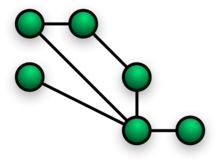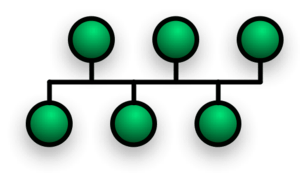Objective 2.3: Physical Topologies
< Network Plus Certification < Media and Topologies
Objective 2.3: Identify common physical network topologies
A topology is basically a way to organize the network. The physical topology is the way you physically lay out the network, like a map, and the logical topology is the way the information flows on the network. Usually, the physical and logical topology is the same, but sometimes they can differ, such as in a physical star/logical ring topology.
Star

Network where all nodes are connected to a centralized point (Hub or switch).
- Used with: 10BaseT, 100BaseTX
- Pros: Cheap, easy setup and maintenance, reliable, and fault tolerant. Common wired standards of today.
- Cons: In a given collision domain (a hub-based network segment), all nodes receive the same signal, giving rise to collisions and security concerns.
Mesh

Mesh networks differ from other networks in that the different parts can all connect to each other via multiple hops. This allows for rerouting around broken paths by taking an alternate path to the destination. If all nodes in a mesh network are connected to every other node in the network, the network is known as fully connected.
- Used with: WANs (Wide Area Networks), including the Internet.
- Pros: Best fault tolerance available. If one node fails, the network still runs. With some router protocols, traveling packets automatically find the quickest path to take in the network, given the meshed routes.
- Cons: Complicated, expensive, and difficult to set up.
Bus

Network in straight, linear sequence of nodes, terminated on both ends.
- Used with: 10BASE5 (Thicknet), 10BASE2 (Thinnet)
- Pros: Good for small networks. Now considered obsolete.
- Cons: More expensive than the common *BaseT of today. Like Ring-based networks, if one node fails, the entire network goes down. Difficult to troubleshoot. Cables need to be terminated on both ends with terminating devices.
Ring

Network in the form of a ring, where the packets (tokens) move to the next node in the ring. Only one node has the token at any one time. This is usually a logical token ring with a physical star topology.
- Used with: FDDI (Fiber Distributed Data Interface) and Token Ring
- Pros: Low signal degeneration. Since only one node can pass the token at any one time, it inherently reduces collisions significantly.
- Cons: Expensive. Difficult to find a problem segment. If one node fails, whole network goes down. Dual-ring implementations provide redundancy and makes failures less likely.
Point-to-point
A switch provides a series of point-to-point circuits, via microsegmentation, which allows each client node to have a dedicated circuit and the added advantage of having full duplex connections.
Point-to-multipoint
A hub provides a point-to-multipoint (or simply multipoint) circuit which divides the total bandwidth supplied by the hub among each connected client node. This topology is seen in ATM (Asynchronous Transfer Mode) and Frame Relay links, as well as X.25 networks when used as links for a network layer protocol like IP (Internet Protocol).
Hybrid
Hybrid networks use a combination of any two or more topologies in such a way that the resulting network does not exhibit one of the standard topologies (e.g., bus, star, ring, etc.). For example, a tree network connected to a tree network is still a tree network, but two star networks connected together exhibit a hybrid network topology. A hybrid topology is always produced when two different basic network topologies are connected. Two common examples for Hybrid network are: star ring network and star bus network
- A Star Ring network consists of two or more star topologies connected using a MAU (Media Access Unit) as a centralized hub.
- A Star Bus network consists of two or more star topologies connected using a bus trunk (the bus trunk serves as the network's backbone).